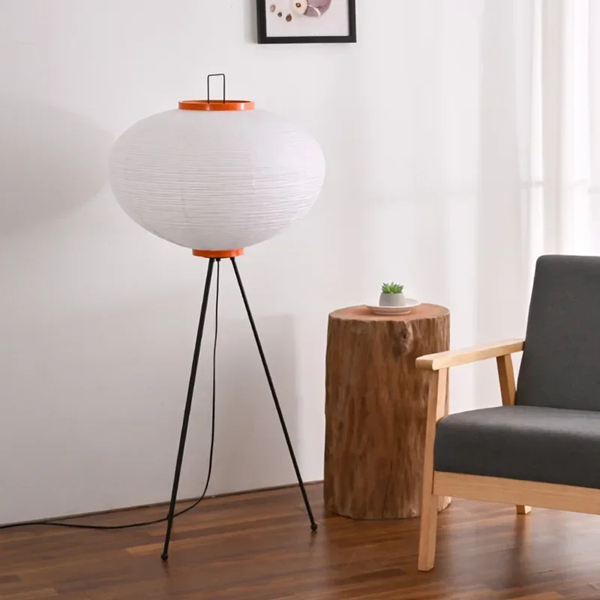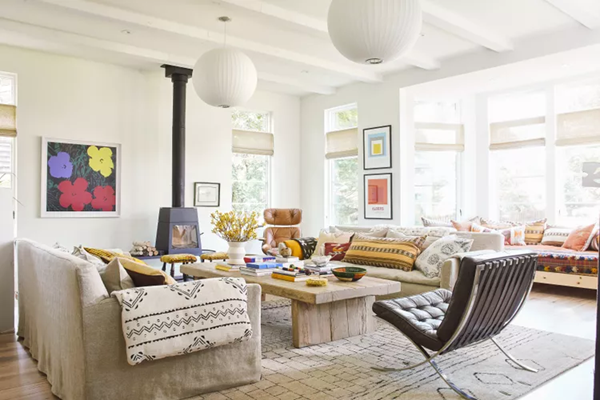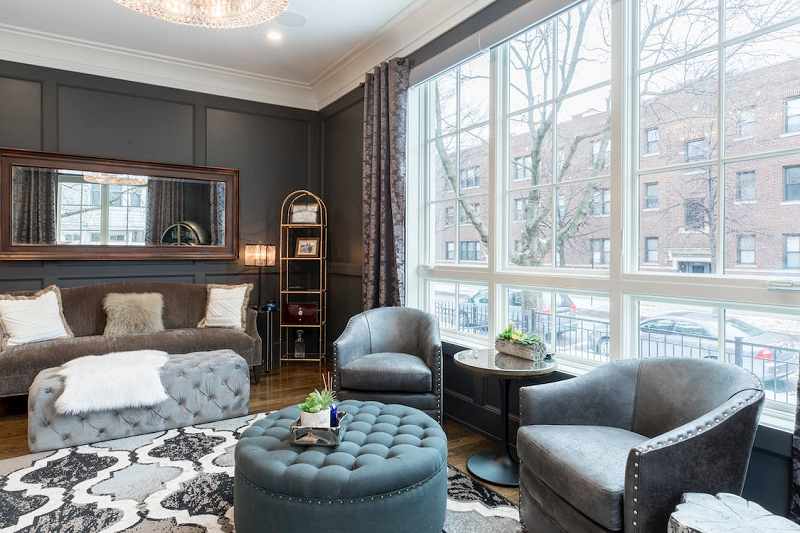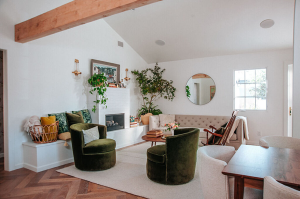
Ever feel like your living room, especially your Japandi living room, resembles a cluttered battlefield after a long day? Yearning for a space that feels like a tranquil escape, a haven of serenity bathed in warm sunlight? Look no further than the upcoming trend of Japandi style.
This design movement, a beautiful fusion of Japanese minimalism and Scandinavian functionality, isn’t just about aesthetics. It’s about transforming your living room into a space that soothes your soul, boosts your focus, and promotes a sense of well-being.
Intrigued? Dive deeper with me as we explore the transformative effects of a Japandi living room and discover how it can elevate your space and your well-being in surprising ways.
What is Japandi Style?

Before we get into creating your dream Japandi living room, let’s take a quick moment to understand the essence of this design style. Japandi living rooms capture the beautiful synergy between Japanese minimalism and Scandinavian functionality. Imagine incorporating the clean lines and natural materials favored by the Japanese aesthetic, alongside the focus on comfort and light characteristic of Scandinavian design. The result? A serene, organized, and calming living space that promotes both form and function.
“Japandi design is about finding beauty in simplicity and functionality. It’s about creating a space that feels calming and serene, while also being comfortable and inviting.”
Says Sarah Sherman Samuel, Interior Designer
Positive Effects of a Japandi Living Room

Imagine stepping into your living room after a long day and feeling an instant wave of calm wash over you. That’s the magic of a Japandi living room! The core principles of this style – clean lines, natural materials (think warm wood and woven textures), and a focus on neutral color palettes (think calming beiges and soft greys) – all come together to create a naturally Japandi living room that feels peaceful and stress-reducing.
“If you are looking for a way to style your space with wall art without breaking your piggy bank, then I recommend reading “10 Surprising Benefits of Printable Wall Art”
But it’s not just about the visual elements. A Japandi living room also prioritizes natural light and a connection with nature. Think expansive windows that bathe the space in sunlight and pops of green with houseplants strategically placed throughout the room. The growing trend of biophilic design integration within Japandi living rooms takes this connection even further, bringing the calming influence of nature even deeper into your space.
The Transformative Power of a Japandi Living Room

Imagine stepping into your living room after a long day and feeling an instant wave of calm wash over you. That’s the magic of a Japandi living room! The core principles of this style – clean lines, natural materials (think warm wood and woven textures), and a focus on neutral color palettes (think calming beiges and soft greys) – all come together to create a naturally Japandi living room that feels peaceful and stress-reducing.
“The core of Japandi living is about connecting with nature and bringing the outdoors in. This can be achieved through the use of natural materials, light, and plants.”
Mika Yokoyama, Japanese Design Expert
But it’s not just about the visual elements. A Japandi living room also prioritizes natural light and a connection with nature. Think expansive windows that bathe the space in sunlight and pops of green with houseplants strategically placed throughout the room. The growing trend of biophilic design integration within Japandi living rooms takes this connection even further, bringing the calming influence of nature even deeper into your space.
Let’s move from tranquility to functionality. How can a Japandi living room actually improve your focus and organization?
Boosting Focus and Functionality

Ever feel overwhelmed by the clutter in your living room? A Japandi living room is your answer! This design philosophy emphasizes functionality, promoting a clutter-free and organized space that allows you to breathe and focus.
The key lies in multifunctional furniture and space-saving solutions. Think ottomans with hidden storage compartments, coffee tables that convert into desks, and sleek shelving units that maximize vertical space. This is particularly relevant for small apartment dwellers, where every square foot counts in a Japandi living room.
But functionality doesn’t have to come at the expense of aesthetics. The growing popularity of sustainable materials in Japandi living rooms allows you to embrace eco-friendly choices without compromising on style. Think recycled wood furniture, woven baskets made from natural fibers, and organic cotton throw pillows. These choices not only contribute to a naturally Japandi living room but also align with the philosophy’s emphasis on mindfulness and responsible living.
Now, let’s delve deeper into the surprising link between a Japandi living room and your overall well-being.
A Haven for Your Mind and Soul

The minimalist aesthetic of a Japandi living room goes beyond just creating a stylish space. Studies have shown that minimalist environments can promote feelings of peace, reduce stress, and enhance mindfulness. By eliminating clutter and visual noise, a Japandi living room allows you to focus on what truly matters, fostering a sense of calmness and mental clarity.
“Minimalism isn’t about deprivation, it’s about intentionality. When you have fewer things, you can focus on the quality and purpose of each item in your space.”
Says Joshua Becker, Author of “The Minimalist Home“
This philosophy even embraces the concept of Wabi-Sabi, a Japanese aesthetic that celebrates imperfection and finds beauty in the natural aging of materials. In a Japandi living room, embracing minor imperfections and focusing on the functionality and natural beauty of objects can contribute to a sense of acceptance and inner peace.
Ready to experience the transformative effects of a Japandi living room for yourself? Dive deeper into the next section to learn how to get the Japandi look!
Getting the Japandi Look:

Now that you’ve experienced the transformative power of a Japandi living room, let’s dive into how to create this haven in your own space. Here’s the key: simplicity with intention and embracing the natural world.
Furniture Essentials:

Think clean lines and organic materials. Opt for low-profile sofas or futons made from light wood like oak or ash. Consider incorporating a touch of bamboo or rattan through accent chairs or side tables for added texture. Remember, functionality is key! Ottomans with hidden storage compartments and coffee tables that convert into desks are lifesavers in smaller spaces.
Japandi Lighting:

Banish harsh overhead lights. Layer your lighting scheme with soft, natural-looking elements. Floor lamps with rice paper shades cast a warm glow, while strategically placed pendant lights made from woven materials like wicker add a touch of rustic charm. Don’t forget the power of natural light! Maximize it with strategically placed curtains or blinds in light, neutral tones.
Japandi Walling:

Keep your walls a blank canvas for tranquility. White, beige, or light gray are perfect for creating a calming foundation. Want a touch of drama? Consider a single accent wall in a muted earthy tone like sage green or a soft brown.
Japandi Flooring:

Wood is the natural choice here! Opt for light-colored wood floors in a light stain or even a natural, unfinished look. Light-colored laminate or vinyl flooring can also achieve a similar effect. Consider incorporating area rugs made from natural fibers like jute or sisal to add warmth and texture, especially in high-traffic areas.
Texture and Layering: The Art of Cozy Minimalism

Japandi isn’t about cold sterility; it’s about creating a warm and inviting space. Here’s where texture comes in! Layer throw pillows and blankets made from natural fibers like wool, linen, or organic cotton on your sofa. Don’t be afraid to mix and match patterns – stripes, geometric shapes, and even a touch of floral can add visual interest without overwhelming the space.
Japandi Wall Art:

Let your personality shine through with a curated selection of wall art. Think minimalist prints with nature themes, Japanese woodblock prints, or even a simple woven wall hanging. The key is to keep it cohesive with the overall neutral color palette.
Japandi Ornaments: The Finishing Touches

Carefully chosen ornaments add personality and a touch of whimsy to your Japandi living room. Opt for natural materials like ceramic vases, woven baskets, or even a beautiful bonsai tree. A single statement piece, like a sculptural vase or a piece of driftwood, can add a touch of zen sophistication. Remember, when it comes to ornaments, less is truly more in Japandi design.
Budget-Friendly Japandi: Achieving the Look Without Breaking the Bank

Creating a Japandi living room doesn’t have to be expensive! Here are some tips:
- Thrift stores and flea markets are treasure troves for finding unique furniture pieces with a little Japandi potential. A vintage coffee table with clean lines can be easily refinished to achieve the natural wood look.
- DIY projects can add a personal touch and save money. Repurpose old furniture with a fresh coat of paint or reupholster a chair in a natural-colored fabric.
- Natural elements are often free! Decorate with branches collected on a walk or use pebbles from your backyard in a decorative bowl for a touch of natural beauty.
By following these tips and letting your creativity flow, you can transform your living room into a haven of peace and tranquility, all within a budget. So, embrace the Japandi philosophy, bring nature indoors, and create a living space that reflects your mindful approach to life.
Sustainability and Eco-Conscious Choices in Japandi Living Rooms

The philosophy of Japandi extends beyond aesthetics; it emphasizes mindfulness and responsible living. This translates beautifully into the realm of sustainable choices for your Japandi living room. Here’s how you can embrace eco-consciousness while creating your haven:
“Sustainability is a journey, not a destination. By making small changes in your everyday life, you can make a big impact on the environment.”
Says Melissa Harris, Eco-Lifestyle Blogger
Embrace Sustainable Materials:
- Recycled wood furniture: Opt for furniture crafted from recycled wood or reclaimed materials. This not only reduces environmental impact but also adds a unique character to your space.
- Natural fibers: Choose textiles and rugs made from natural fibers like organic cotton, linen, jute, or sisal. These materials are not only sustainable but also offer a beautiful textural element.
- Energy-efficient lighting: Invest in LED lighting options for your living room. LEDs use significantly less energy than traditional bulbs, reducing your carbon footprint and saving you money on electricity bills.
- Upcycled and vintage finds: Breathe new life into pre-loved furniture and decor pieces. This not only adds a touch of personality but also reduces your reliance on new, resource-intensive products.
Beyond Materials:
- Mindful consumption: Resist the urge to impulse buy. Instead, invest in well-made, timeless pieces that will last for years. This not only saves you money in the long run but also reduces waste.
- Sustainable practices: Consider energy-saving habits like using natural light whenever possible and unplugging electronics when not in use.
- Support eco-conscious brands: When purchasing new items, seek out brands committed to sustainable practices and ethical production.
By incorporating these eco-conscious choices, you can create a Japandi living room that reflects a mindful approach to living, minimizing your environmental impact while fostering a sense of peace and tranquility in your space. Remember, even small changes can make a big difference.
Addressing Common Challenges in Creating a Japandi Living Room

While the Japandi aesthetic is undeniably beautiful and serene, achieving this look in your own space can come with its own set of challenges. Here are two common hurdles you might face, along with solutions to help you overcome them:
Challenge 1: Limited Space:
Living in a small apartment doesn’t mean you have to sacrifice the calming influence of a Japandi living room. Here are some clever solutions to maximize space and embrace the Japandi philosophy:
- Multifunctional furniture: Invest in pieces that serve multiple purposes. Ottomans with hidden storage compartments can double as extra seating and provide much-needed storage. Opt for coffee tables that convert into desks or nesting tables that tuck away neatly when not in use.
- Smart storage solutions: Utilize vertical space with strategically placed shelving units or wall-mounted cabinets. Invest in sleek and minimalist storage solutions that blend seamlessly with the overall aesthetic.
- Folding furniture: Consider incorporating folding chairs, screens, or even a futon that can be easily tucked away when not in use, creating a more spacious feel when needed.
Challenge 2: Budget Constraints:
Creating a Japandi living room doesn’t have to break the bank. Here are some budget-friendly tips to help you achieve the look without compromising on style:
- Think pre-loved: Explore thrift stores, flea markets, or online marketplaces for unique furniture pieces with Japandi potential. With a little paint, reupholstery, or refinishing, you can transform a pre-loved piece into a stunning statement item.
- Embrace DIY projects: Unleash your creativity and tackle some DIY projects. Repaint old furniture in neutral tones, reupholster chairs in natural fabrics, or create your own wall art using natural materials like driftwood or pebbles.
- Shop strategically: Look for sales and explore discount furniture stores for pieces that fit the minimalist aesthetic. Remember, you don’t have to furnish your entire living room at once. Start with key pieces and gradually add more over time.
By being resourceful and creative, you can overcome these common challenges and create a beautiful and serene Japandi living room that reflects your unique style and budget.
Pros and Cons of the Japandi Living Room Style

The Japandi aesthetic, a beautiful blend of Scandinavian minimalism and Japanese Zen design, has taken the interior design world by storm. But before you embark on your Japandi living room transformation, weigh the pros and cons to see if it aligns with your lifestyle.
Pros:
- Tranquility and Reduced Stress: The core principles of Japandi, clean lines, natural materials, and a calming color palette, all contribute to a space that feels peaceful and promotes feelings of well-being. Studies have shown that minimalist environments can reduce stress and enhance feelings of calmness.
- Improved Focus and Functionality: A Japandi living room prioritizes functionality and eliminates clutter. Multifunctional furniture and space-saving solutions create an organized environment that allows you to focus on what truly matters.
- Connection with Nature: Japandi design emphasizes a connection with the outdoors. Natural light, houseplants, and earthy tones bring the calming influence of nature into your living space.
- Sustainability: The Japandi philosophy aligns with mindful living and responsible consumption. The use of sustainable materials like recycled wood and organic cotton, coupled with a focus on quality over quantity, reduces environmental impact.
- Timeless Style: The minimalist aesthetic and focus on natural elements ensure that a Japandi living room won’t go out of style quickly. It’s a classic look that will endure for years to come.
Cons:
- Limited Color Palette: While the neutral color palette is elegant, some might find it too subdued and prefer a more vibrant living space.
- Potential Sterility: Overemphasis on minimalism can lead to a space feeling sterile or lacking in personality. Striking the right balance between clean lines and warmth is key.
- Space Planning Challenge: While Japandi can work in smaller spaces, maximizing functionality requires careful space planning, especially when dealing with limited square footage.
- Upfront Investment: High-quality natural materials often used in Japandi design can be more expensive than readily available mass-produced furniture. However, mindful shopping and upcycling can help mitigate this cost.
- Not for Maximalists: If you thrive on a vibrant and cluttered environment, Japandi might not be the ideal style for you. It embraces a pared-down aesthetic that prioritizes clean lines and a sense of order.
By weighing the pros and cons and considering your personal preferences and lifestyle, you can decide if the Japandi living room is the perfect tranquil haven for you.
Most Popular Post:
10 Surprising Benefits of Printable Wall Art
How to Choose The Right TV Size to Decorate Your Living Room
The ultimate Smart Home Design Guide: Automate your life
Tips for Home Decorating on a Budget: Where to Splurge and Save
10 Best Couch Colors That Make a Room Look Bigger
Conclusion: The Lasting Impact of a Japandi Living Room
Creating a Japandi living room goes beyond just achieving a stylish aesthetic. It’s about cultivating a space that fosters peace, mindfulness, and a deeper connection with nature. By embracing the core principles of clean lines, natural materials, and a calming color palette, you can transform your living room into a haven that promotes:
- Reduced stress and enhanced feelings of calmness: The minimalist aesthetic and focus on natural elements can contribute to a sense of tranquility and mental clarity.
- Improved focus and mental clarity: The clutter-free and organized nature of a Japandi living room can help you declutter your mind and improve your ability to focus.
- A deeper connection with nature: Bringing the outdoors in through houseplants, natural materials, and ample natural light can foster a sense of connection to the natural world, reducing feelings of isolation and promoting well-being.
- A more mindful and sustainable lifestyle: The emphasis on natural materials, upcycling, and energy-efficient choices encourages mindful consumption and responsible living, contributing to a more sustainable lifestyle.
Remember, creating a Japandi living room is a journey, not a destination. Embrace the process, be creative, and don’t be afraid to personalize the space to reflect your unique style and values. By incorporating the tips and suggestions outlined above, you can embark on this journey and experience the transformative power of bringing the Japandi philosophy into your home.
FAQs: Creating Your Dream Japandi Living Room
Q: What if I don’t have a lot of natural light in my living room?
A: While natural light is ideal for a Japandi living room, it’s not always possible. Here are some alternatives:
- Utilize light-reflecting surfaces: Paint your walls white or a light neutral color to reflect and maximize any available natural light. Consider mirrors strategically placed to bounce light around the room.
- Invest in warm, dimmable lighting: Opt for floor lamps with rice paper shades or pendant lights made from natural materials to create a warm and inviting ambiance.
Q: Can I incorporate color into a Japandi living room?
A: While Japandi leans towards a neutral color palette, pops of color can certainly be incorporated. Use them strategically for subtle contrast or as a way to reflect your personality. Consider:
- Earthy tones: Light green, brown, or beige can add a touch of nature and warmth.
- Black or dark blue: Introduce these in throw pillows, artwork, or lampshades for a touch of definition and drama.
Q: How can I make my Japandi living room comfortable and inviting?
A: While minimalism is key, comfort shouldn’t be sacrificed. Here are some tips:
- Layer textures: Use soft throws, cushions, and rugs made from natural fibers like wool, linen, or cotton to add warmth and visual interest.
- Introduce greenery: Houseplants not only purify the air but also add a touch of life and vibrancy to your space.
- Personalize with meaningful objects: Don’t be afraid to display artwork, photographs, or other objects that hold personal significance to you.
Q: Is Japandi a good style for small apartments?
A: Absolutely! The emphasis on clean lines, multifunctional furniture, and clever storage solutions makes Japandi perfectly suited for maximizing space in smaller living areas.
Q: Where can I find inspiration and resources for creating a Japandi living room?
A: Here are some resources to get you started:
- Online articles and videos showcasing Japandi living room examples.
- Online stores or local shops selling Japandi-inspired furniture and decor.
- Books and magazines featuring Japandi design inspiration.
By following these tips and letting your creativity flow, you can transform your living room into a haven of peace and tranquility, embracing the essence of Japandi living.
CATCH THE LATEST IN HOME DECOR TRENDS:

Steal These 15 Expert-Approved Decorating Secrets

How To Accessories Your Living Room

Small Space? 10 Ways To Make A Room Appear Bigger

Make Your space Look Expensive
GET CAUGHT UP ON ALL THE INSPIRING DECOR TIPS:

18 Fresh Decorating Ideas To Update Your Fireplace

How To Create An Art Gallery Wall
